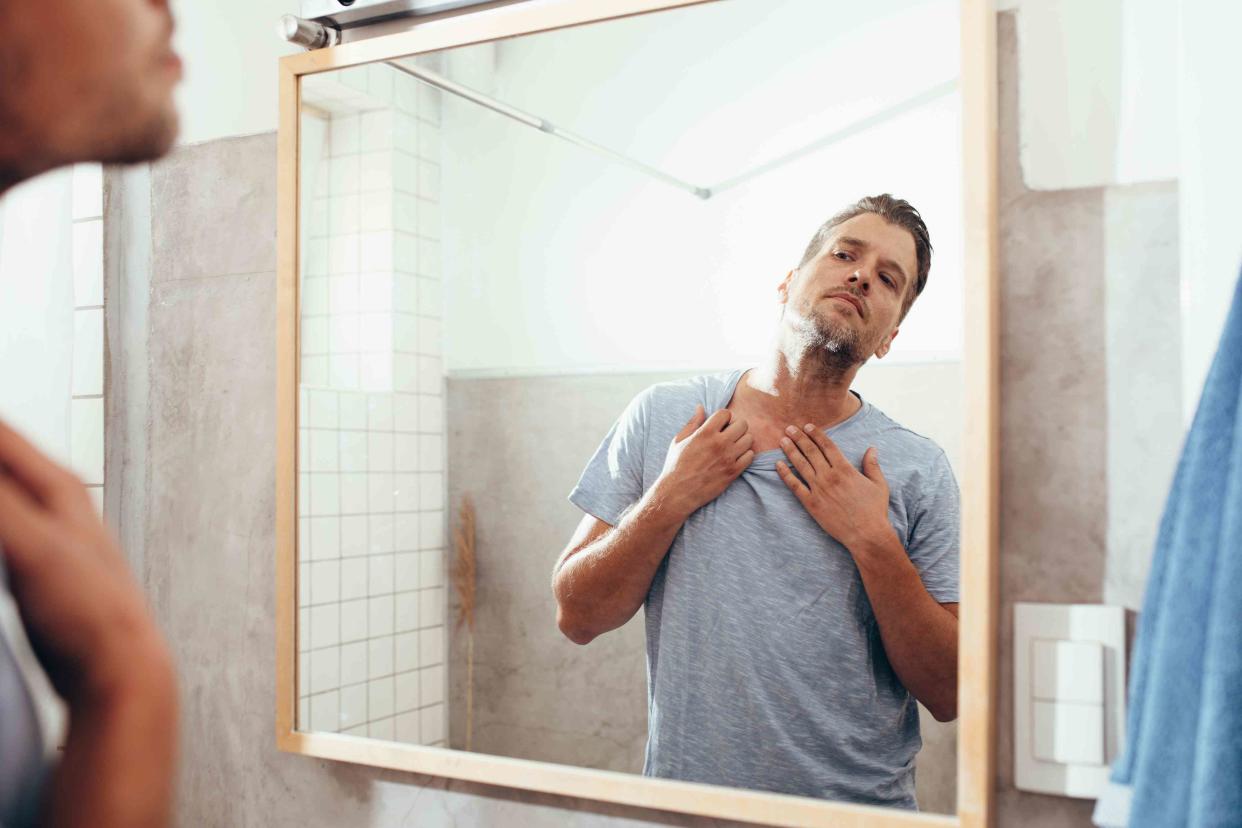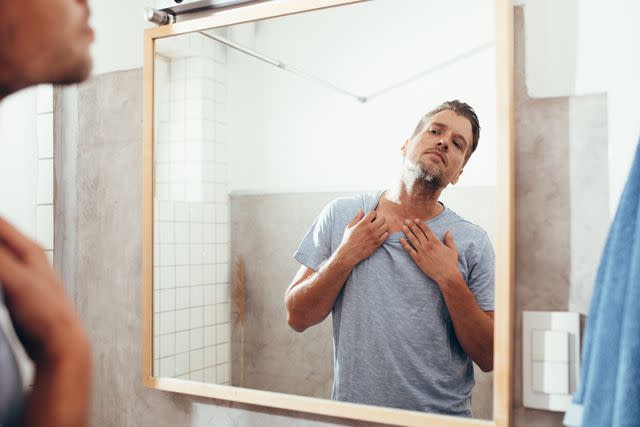Getting Rid of Grover’s Disease: What Stops the Itch?

miniseries / Getty Images
Medically reviewed by William Truswell, MD
Grover's disease—also called transient acantholytic dermatosis—is a rare skin condition usually causing a rash on your chest and back. The term "transient," refers to the fact that the rash comes and goes.
Grover's disease most often occurs in White males who are age 50 and older. Symptoms usually appear as a trunk rash with very itchy red spots. Most cases of this disease last six to 12 months, though it can remain longer.
While the cause of this problem is unknown, most outbreaks can be managed. Treatments range from home remedies to prescribed therapies. These include creams, ointments, pills, injections, and/or phototherapy (light therapy) based on the degree of your problem.
This article describes common symptoms and treatments used in Grover's disease.

miniseries / Getty Images
Temporary Grover's Disease Symptoms
Temporary Grover's disease can be hard to identify, especially when symptoms begin. It usually starts as an itchy chest or an itchy spot on your back, then quickly spreads and includes the following symptoms:
Small, itchy red bumps that become crusted
Blisters that contain a hair follicle and a thin, watery fluid
A rash on the neck, chest, and back
Clumps of blisters surrounded by a swollen red ring
Occasional appearance of rash on arms and legs
Mild to intense itching that worsens with exposure to heat or extensive sweating, cold and dry air, and exposure to ultraviolet light
Extreme itching that affects your quality of life
Grover's disease usually lasts from six months to one year and is more common onset in the winter months
Drugs That May Increase Your Risk of Grover's Disease
Though it is unclear whether the following drugs contribute to the onset of Grover's disease, the condition has been reported with the use of the following drugs:
BRAF inhibitors (drugs that inhibit BRAF mutations, which are DNA changes in some cancer cells) including the following:
Zelboraf (vemurafenib)
Tafinlar (dabrafenib)
Braftovi (encorafenib)
Cytotoxic chemotherapy drugs (a group of 80 chemotherapy drugs that are toxic to cells, including cancer cells) including the following:
Cytoxan (cyclophosphamide)
DTIC-Dome (dacarbazine)
Oncovin (vincristine)
When to See a Dermatologist for Grover's Disease
You will not be able to diagnose Grover's disease on your own. Since the disease is relatively rare, it may not be recognizable to the untrained eye. It can easily be confused with other rashes, as well. A dermatologist (a specialist in medical conditions of the skin, hair, and nails) can identify the disease and manage your treatment.
While most rashes are not a life-threatening condition, they may be a sign of a serious problem that warrants further assessment or treatment. The most common reason for visiting a dermatologist is when the severe itching interferes with daily life.
The American Association of Dermatology Association (AAD) advises that you see a dermatologist if any of the following characteristics accompany your rash:
Coverage over your entire body
Rapid and sudden spread
Difficulty breathing, indicating a potential allergy
Blistering
Painful or severe itching interfering with your quality of life
Signs of an infection, such as a yellow or green fluid, crusting, swelling, or a red streak in the area of the rash
Your dermatologist will make a diagnosis using the following criteria:
Physical examination of your skin for signs and symptoms of Grover's disease using a dermoscope, a specialized magnifying lens
Information about your symptoms and your exposure to risk factors linked to Grover's disease
Direct immunofluorescence stainin, which is the use of fluorescent dyes to visualize molecules under a light microscope
Potassium hydroxide (KOH) prep test, a test used to diagnose fungal infections of the skin
Skin biopsy, which is removing a tissue sample from the affected area for examination under a microscope, considered the gold standard for a definitive diagnosis of Grover's disease
Learn More: A Guide to Which Rashes You Should Worry About
Treatment for Mild Grover's Disease
While some cases of Grover's disease resolve on their own, there is no need to allow symptoms to remain untreated. Though there is no cure, the following therapies can provide relief to help reduce inflammation and itching, which can be valuable in preserving your quality of life:
Antihistamines, including Benadryl (diphenhydramine) and Vistaril (hydroxyzine)
Anti-itch products that contain local anesthetics including menthol, pramoxine, or camphor
Topical steroids in varying strengths, including Clobex, Embeline, others (clobetasol), Generic hydrocortisone) 1% creams, ointments, and lotions, Hytone (hydrocortisone) 2.5% cream and lotion, and Kenalog (triamcinolone)
Topical vitamin D analogs (drugs that work by increasing vitamin D levels and helping your body absorb more calcium) including Dovonex, Sorilux (calcipotriene 0.005% cream), Enstilar, Taclonex, or Wynzora (calcipotriene 0.005% and betamethasone dipropionate 0.064% foam)
Some people achieve symptom relief with the following natural remedies for Grover's disease:
Carrot juice (consumed orally)
Borage oil (applied to the rash)
Coconut oil (applied to the rash)
Marshmallow root and papaya leaf
Neem leaves (crushed in a paste and applied on the rash)
Olive oil (applied to the rash)
Supplemental vitamin C (consumed orally)
Tea tree oil (applied to the rash)
Learn More: 5 Essential Vitamins for Skin Health
Treatment for Severe Grover's Disease That Lasts Longer
Though Grover's disease is not life-threatening, it can cause severe itching that interferes with your quality of life. While the condition is transient, it can come and go in multiple episodes.
When first-line therapies such as topical steroids don't provide relief and itching is intense, the following treatments may be used:
Oral prescription retinoids, including the following:
Soriatane (acitretin)
PUVA phototherapy (a type of ultraviolet light therapy used with psoralen, a chemical that makes your skin temporarily more sensitive to light)
Diflucan (fluconazole) and other antifungal oral medications
Cortisone injections (synthetic versions of the natural corticosteroids that your body makes to control inflammation)
Is Grover's Disease an Autoimmune Condition?
The involvement of autoimmune mechanisms in the onset of Grover's disease is controversial. Research indicates an autoimmunity component tied to Grover's disease, but it isn't clear whether the antibodies cause or are caused by the condition.
Self-Care Treatment for Grover's Disease
While you are waiting for prescription medication to resolve symptoms of Grover's disease, self-care treatments can help you avoid known triggers. To do this, take the following measures:
Remain cool to prevent sweating.
Avoid excessive sun exposure.
Use mild topical steroids (hydrocortisone) or oral antihistamines (Benadryl) if the lesions are itchy.
Keep your skin moist with a bland emollient like Eucerin or Cetaphil cream.
Avoid prolonged bed rest.
Don't wear very tight clothing.
Wear moisture-wicking clothing.
Reduce stress and anxiety.
Learn More: Causes of Itchy Skin and Treatment Options
Which Foods to Eat and Avoid With Grover's Disease
While the cause of Grover's disease is unknown, certain foods have demonstrated therapeutic and health-promoting effects in some inflammatory skin conditions.
Consider the following when choosing foods.
Foods with omega-3 fatty acids can have suppressive and anti-inflammatory impact. Foods that provide omega-3s include the following:
Fish and other seafood (especially coldwater fatty fish, such as mackerel, salmon, herring, tuna, and sardines)
Nuts and seeds (such as flaxseed, chia seeds, and walnuts)
Fortified foods (such as certain brands of eggs, yogurt, juices, milk, and soy beverages
Plant oils (such as flaxseed oil, soybean oil, and canola oil)
Foods with Vitamin C, including the following:
Oranges
Peppers
Strawberries
Broccoli
Foods high in antioxidants, including the following:
Red kidney beans
Black beans
Leafy green vegetables
Berries
Eggplant
Tomatoes
Apples
Dark chocolate
Tea
Foods high in vitamin E:
Sunflower seeds
Spinach
Almonds
Peanuts
Avocados
Avoid eating the following foods that may trigger or aggravate itchy skin. This can include the following.
Refined sugar and refined carbohydrates often found in the following foods:
Breads
Sodas
Candy
Cookies
Cakes
Fruit drinks
Yogurts
Dairy:
Milk
Cheese
Ice cream
Yogurt
Meats with nitrates or nitrites:
Bacon
Hot dogs
Other processed meats, like lunch meat
Whey protein, excess coffee, fried foods, and alcohol can also trigger and aggravate the skin.
Co-Occurring Conditions in Grover's Disease Patients
There is no known cause for Grover's disease. However, the following conditions can co-occur with Grover's disease or worsen its symptoms:
History of cancer, often with chemotherapy
Extended bedridden condition or hospitalization
Contact dermatitis
Xerosis cutis (dry skin)
Since Grover's disease typically occurs in men age 50 and over, the possibility of having multiple comorbidities (other conditions) commonly experienced in older age increases. Using drugs and therapies for other conditions can potentially complicate the effectiveness of treatment options such as steroids and retinoids.
Summary
Grover's disease is a skin problem that most often affects your back, neck, and chest. It causes a rash that results in small red and itchy bumps.
Diagnosis often involves a skin biopsy to rule out other skin problems. While this condition often resolves on its own within six to 12 months, it can recur many times.
There is no cure for this problem. Treatment centers on soothing symptoms so you can maintain your quality of life until the issue runs its course. Without treatment, intense itching can affect your daily life and even prevent sleep.
Early diagnosis can help you receive prompt treatment to help prevent the problem from becoming severe. This disease is not life-threatening.

